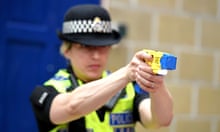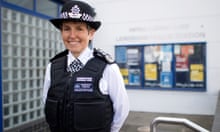The Metropolitan police will significantly increase the number of officers carrying Taser electronic weapons, to offer them more protection against a rising tide of violence.
Under the plans announced on Tuesday, another 1,867 officers will carry the devices, taking the total in the Met to 6,400 of its frontline staff, who police chiefs hope will be better able to defend themselves and the public.
The move has been approved by the Met commissioner, Cressida Dick. It comes as Britain faces an unprecedented terrorism threat, with London assessed by counter-terrorism chiefs to be most at risk of attack.
Britain’s top police chief says increasing the number of officers carrying the stun guns is necessary to protect against rising knife crime and assaults on officers.
About 4,000 out of 31,000 Met officers are trained and authorised to carry the devices.
The Met aims to have more than 1,000 officers armed with stun guns on the streets of the capital at any one time, the Guardian understands.
Amnesty International criticised the Met’s decision and accused the force of failing to live up to its promises to consult properly. The human rights group urged Dick to place her decision on hold, saying the weapons would make London more dangerous.
Announcing the decision, Dick said: “With this uplift, my officers will be better equipped to protect the public and themselves. We know that the mere presence of a Taser is often enough to defuse a dangerous situation and often get a suspect to drop their weapon if they’re armed.”
To justify the decision, the Met cited figures showing that knife crime offences rose 24% in the past year. Attacks on officers have also increased, from 2,211 in 2014 to 2,676 in 2016.
The Met also said the mere threat of using a Taser causes suspects to comply, and there is no need to fire it almost nine out of 10 times when an officer points it at a suspect.
Dick said: “Taser reduces the need for physical contact and also the risk of unintended or unnecessary injuries to all parties.”
Theresa May, while home secretary, was concerned about disproportionate use of Tasers against ethnic minorities. Police chiefs are combining more officers armed with the weapon with increased use of body-worn cameras.
Dick said: “With the rollout of body-worn cameras to every uniformed officer, the public can also rest assured that the use of Taser is correctly recorded and monitored and that the use of it is subject to comprehensive scrutiny.”
Rank-and-file officers believe the terrorist threat means they need more protection. The concern after the three attacks on the capital since March is that officers cannot wait for colleagues with Tasers or guns to arrive.
In the attack this month on London Bridge and Borough Market, police with batons were the first to try to stop three terrorists armed with knives who stabbed five people to death. It took armed police eight minutes to arrive, locate and kill the attackers, which was seen as quick, but left regular officers facing a lethal threat without the means to properly defend themselves or others.
Tasers have been linked to a number of deaths. The weapons deliver a 50,000-volt shock to incapacitate a suspect and critics say they are too often lethal.
A Taser was used to stop an attacker who stabbed passersby at Leytonstone tube station in 2015. In 2015 the Police Federation called for every frontline officer in England and Wales to be offered a Taser.
Some police chiefs fear that the prospect of more officers armed with Tasers risks changing the traditional face of policing, which is unarmed.
Police forces are moving to a new Taser model, the X2. It costs about £1,500, and is three times more expensive than a Glock handgun.
The Children’s Rights Alliance for England expressed concern about more officers being issued with the devices, saying: “The more Tasers we have on our streets, the more they are used on children and the more chances there are of mistakes being made, making children less safe.”
Oliver Sprague, the director for police at Amnesty International, said: “As part of the Taser reference group, we are shocked that we’ve simply been informed and not properly consulted about such a major development in Taser usage, when the purpose of that group is to provide consultation and critical oversight of Taser use by the police.
“Tasers are potentially lethal weapons that require very careful scrutiny and training to ensure they are used safely and properly in accordance with established medical and legal standards. In the absence of these safeguards, issuing more Tasers will make Britain’s streets more dangerous, not safer.”
Responding to Amnesty’s criticism, the Met said: “We are speaking with stakeholders across London and will seek to address any concerns they and the public may have.”








